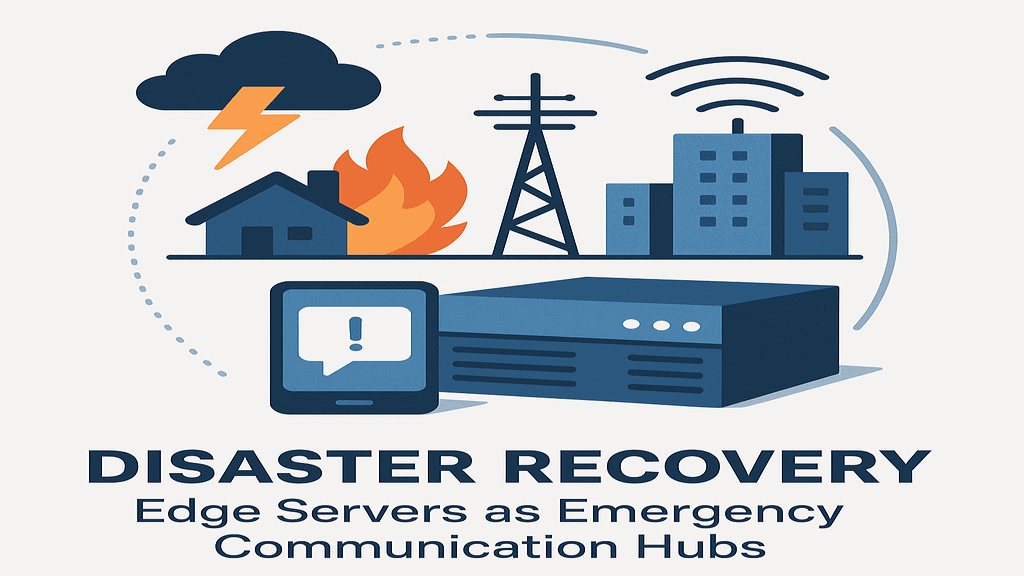Natural or man-made disasters pose a serious threat to communications continuity in this era of reliance on technology. Edge servers serve as decentralized, highly reliable emergency communication hubs if traditional networks fail. This isn’t merely hypothetical. It’s taking place on the ground, saving lives, and impacting plans for disaster recovery in the future.
It is not an abstract transformation.
Edge infrastructure has already proven to be a powerful tool for sustaining operations in situations where centralized infrastructures have failed, such as during California wildfires and hurricanes in the Gulf.
Covered Contents
ToggleThe Role of Edge Computing in Modern Disaster Recovery
Historically, disaster recovery was dependent on centralized infrastructure and off-site backup. But the emerging trends in remote work, IoT, and real-time applications have forced computing and storage more towards the source: the edge.
Edge servers are positioned close to the location of data creation—hospitals, branch offices, factories, and even field units. In the event of a disaster, the servers store and process information at the local level, keeping key services intact even if the core network or cloud is inaccessible.
– More than 50% of all new enterprise IT infrastructure will be installed at the edge by 2025, IDC says.
Edge Servers as Emergency Communication Hubs
In times of crisis, communication is the last line of defense. Disasters too often pull down the very infrastructure intended to keep individuals linked together. Edge servers solve this problem by providing
 Resilience at the Local Level
Resilience at the Local Level
Edge servers typically come with battery power supplies, cooling, and hardened enclosures that enable them to function even in extreme environmental conditions.
 Offline Processing
Offline Processing
As opposed to cloud-dependent systems, edge servers do not require permanent connectivity. They keep running mission-critical applications and storing data locally, ensuring fail-safe operation.
 Real-Time Alerts
Real-Time Alerts
Edge devices process information in real time, allowing for immediate alerts and reaction, particularly important in emergency medical treatment, firefighting, and dangerous infrastructure monitoring.
 Secure Communications
Secure Communications
With encryption capabilities integrated into them, firewall protection, and zero-trust architectures, edge servers ensure secure communication channels when conventional IT resources are under duress.
Case Studies: Real Deployments in Action
 ITDRC & WWT: Restoring Connection After Hurricanes
ITDRC & WWT: Restoring Connection After Hurricanes
The Information Technology Disaster Resource Center (ITDRC) and World Wide Technology (WWT) have deployed modular edge kits to disaster-stricken areas in the U.S. These are mobile, edge server- and satellite uplink-powered units that provide internet restoration and emergency communications within hours.
In one high-profile instance with Hurricane Ida, these edge-based hubs supplied Wi-Fi to more than 14,000 displaced residents, enabling them to access emergency services, apply for assistance, and reunite with family members.
 Lanner’s 5G Gateways in Wildfire Hotspots
Lanner’s 5G Gateways in Wildfire Hotspots
In California’s high-risk fire areas, Lanner Electronics deployed durable edge gateways in emergency responders and field stations. The edge systems delivered live drone video, firefighter locations, and smoke analysis over private 5G and SD-WAN. Outcome: 45% shorter response time and improved resource allocation.
Disaster Recovery Architecture with Edge Servers
To have edge servers work efficiently as disaster recovery instruments, organizations need to plan a multi-layered infrastructure:
1. Distributed Edge Sites
Install edge servers in key locations—branch offices, retail stores, utility nodes—without a single point of failure.
2. Hybrid Cloud Sync
There is local processing of data by edges, while regular syncing with cloud ecosystems guarantees long-term backup and centralized management.
3. Failover Load Balancing
Load balancing between the edge and the cloud infrastructure ensures effortless failover if one of the systems fails.
4. Embedded AI & ML
Incorporating AI functionality at the edge facilitates independent discovery of system failures, security violations, or operational risks, enabling preemptive measures.
Challenges of Edge-Based Disaster Recovery
Although benefits are obvious, edge-based DR also brings new challenges:
Scalability: Keeping hundreds of edge sites under management is complicated.
Security: Edge locations can be physically exposed to the outside world and so need robust endpoint security.
Monitoring: Without centralized dashboards, monitoring performance and updates can be tricky.
Cost: Implementing rugged, fail-safe hardware at scale can be capital-hungry.
Organizations require strong orchestration platforms, edge-focused security frameworks, and local training to get past these hurdles.
Best Practices for Deploying Edge DR Solutions
According to observations of TechTarget and Mission Critical Magazine, here’s the way organizations should leverage edge DR:





Industries Leading the Way
Edge-based DR is being quickly embraced in various verticals:
Healthcare: Providing access to patient records and remote diagnosis even in the event of power outages.
Telecommunications: Providing 5G and LTE connectivity across regions where the core networks have been impaired.
Finance: Providing access to ATMs and digital payments even during regional disruptions.
Public Safety: Enabling command-and-control operations at the edge for first responders.
Conclusion:
Disasters are unpredictable. But recovery does not have to be. Edge computing makes disaster response a proactive instead of a reactive capability. With decentralized, smart, and always-on systems, organizations can guarantee business continuity, save lives, and respond quickly, even in the most adverse situations.
The role that edge servers play as emergency communication hubs will only grow as dangers from the climate, cyberspace, and other sources become more serious. The resilient future will be mapped out by those who act now.


